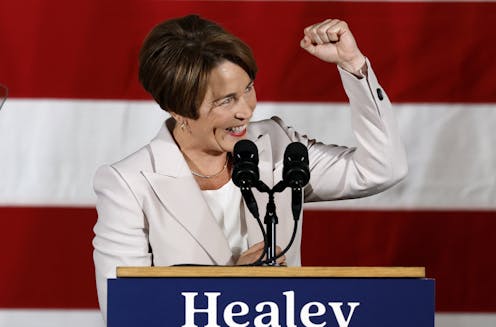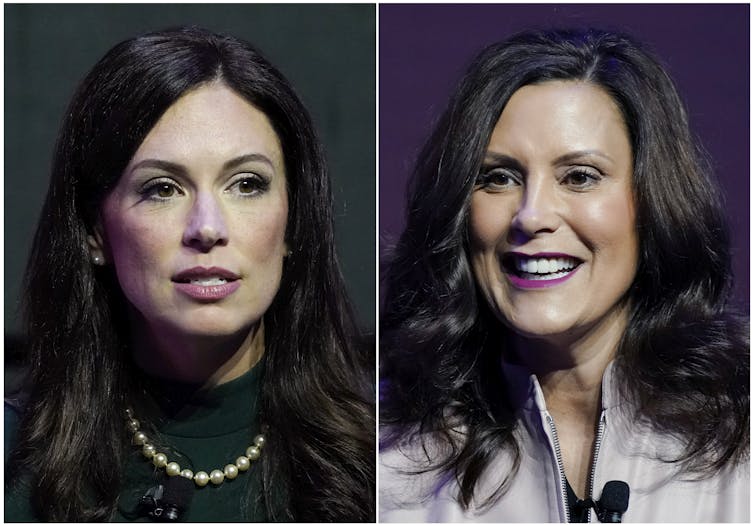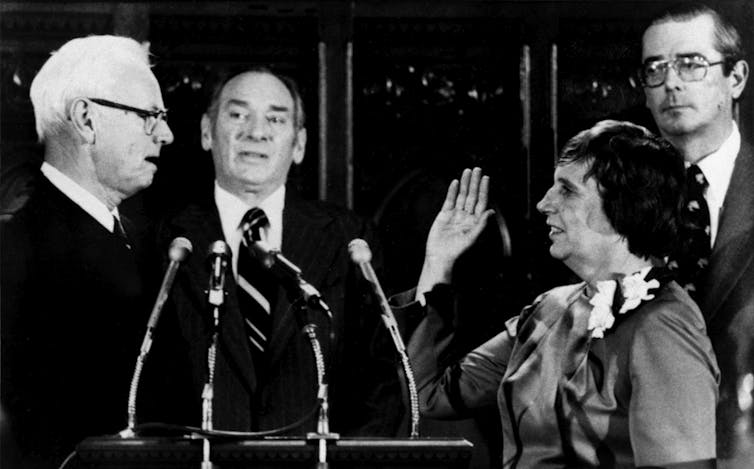
Twelve women won a governor’s office in the November 2022 midterm election. Those 12 represent a record number of women governors, more than one-quarter of the 46 women who have ever served as governor since 1974.
These women are slated to be inaugurated in early January 2023.
A governor heads a state’s executive branch. While their powers vary, governors are essential in writing and passing a state’s budget, shaping legislative priorities, signing bills into law and appointing top officials in the executive branch.
The governorship is a common path to the presidency and the vice presidency, and 19 governors have won U.S. Senate seats since 2000.
Diversity in who is elected governor is important. In a time of decreasing trust in democracy, women governors send a message to all Americans that their government is representative of all its people. In addition, research shows that women governors encourage other women to run for elective office and increase feelings of political efficacy among voters. Political efficacy is the connection citizens feel to their govt, allowing them to believe their input matters. Thus they are more likely to pay attention to the actions of their government and participate in politics.

We are scholars who study American politics and women in politics. To understand the backgrounds of the candidates running for governor in 2022, we have gathered information on the prior political experience of all 420 announced candidates for governor in 2022, and from previous years, stretching back to 1978.
Here are seven things we found out about the record number of recently elected women to governorships and what they mean for American politics.
1. To win, you have to run
While this is obvious, women have historically been more hesitant to run than men. Imposter syndrome, the internalized sense that one is not competent or capable and any success is likely due to luck, is a significant barrier. Women often need to be recruited by political party leaders to run, but men usually decide on their own. A record 91 women candidates ran in primaries for governor in 2022. A record 25 women were major party nominees in the general election. Increased efforts to recruit women candidates, like Republican efforts with Right Direction Women, likely played a role.
2. Political experience matters
Women candidates were more likely to have held political office than their male counterparts in 2022. In the 12 races in which a woman won, each had significant political experience before running for governor.
There has never been a Black woman governor. In order to elect Black women as governors, Black women will need to gain more political experience. There were three Black women candidates, two with political experience, who, while they lost, ran competitive races against incumbents.
Kate Brown was the first openly LGBTQ woman governor. She was Oregon’s secretary of state and then was appointed governor. She was subsequently elected to the position in 2016. Both LGBTQ women who won in 2022 had significant political experience. Maura Healey served as Massachusetts attorney general, and Tina Kotek most recently served as speaker of the Oregon House of Representatives.
3. Democratic and Republican women approach the decision to run for governor differently
Political experience increases the chances of success.
Yet in 2022, Republican women were more willing than Democratic women to run without prior political experience. Over half of Democratic women – 52.5% – running in 2022 had political experience. Only 37.7% of Republican women had political experience.
The Democratic women who became party nominees were more likely to have held prior elective office than Republican women party nominees – 75% to 55.6%. Finally, their success rates differed. All Democratic women candidates who won their race for governor had political experience, versus 75% of the winning Republican women candidates.
4. Incumbency matters
The political science literature has a rich and deep history that documents the difficulty of beating an incumbent. All eight women incumbents who ran, won. In three races, these women incumbents defeated women challengers. And in a year in which a red wave was predicted to unseat Democratic incumbents at all levels of government, Democratic incumbents won, and women Democrats were no different. No Democratic woman incumbent governor lost her race. Ten of the 12 losing women gubernatorial candidates in 2022 faced incumbents. Those women who lost included six women candidates who had never held elective office.

5. Open seats provide opportunities for women candidates
Four women gubernatorial candidates won open seats out of five total open seats. An open seat is one for which no incumbent is running. In two of those open-seat races, both major-party candidates were women.
6. When women run, they are as successful as men
More women are running. There has been a notable change since 1978, when there were nine total women candidates for governor. In the 36 states that held gubernatorial elections in 2022, the number of women candidates increased tenfold from 1978, to 93.
In 2022, women represented 22% of all gubernatorial candidates, the highest percentage ever, and they made up 35% of all major party nominees. More women candidates have led to more women governors. Before 2000, there were never more than four women governors at one time. There are now 12.
7. Governors’ COVID policies differed between men and women
One study found that women governors were less likely to issue stay-at-home orders during COVID than male governors. At the same time, researchers found that women governors were associated with fewer deaths early in the pandemic. In states where women governors issued early stay-at-home orders, these orders were notably more effective in limiting deaths than in states in which male governors issued early stay-at-home orders. In the same research, women governors also were found to be more empathetic and more confident in their messaging during briefings.
No longer an exception
In 1974, Ella Grasso, a Connecticut Democrat, was the first woman elected governor without being the wife or widow of a man in politics. Since then, 45 more women have served as governor. Most early women governors were Democrats, while recently Republicans have elected women, too.
A half-century ago, a woman elected to any office was an exception. This is no longer true.
The 2022 political experience data tells us that women have entered the mainstream of American politics in both parties. Two state legislatures are majority women – Colorado and Nevada. Almost one-third of state legislators will be women in 2023.
Continued party recruitment and support of women to run in lower-level elected offices is key to increasing the number and diversity of women running for, and ultimately serving as, governor.
This article has been corrected to reflect that all Democratic women candidates who won their race for governor had political experience.
The authors do not work for, consult, own shares in or receive funding from any company or organization that would benefit from this article, and have disclosed no relevant affiliations beyond their academic appointment.
This article was originally published on The Conversation. Read the original article.







